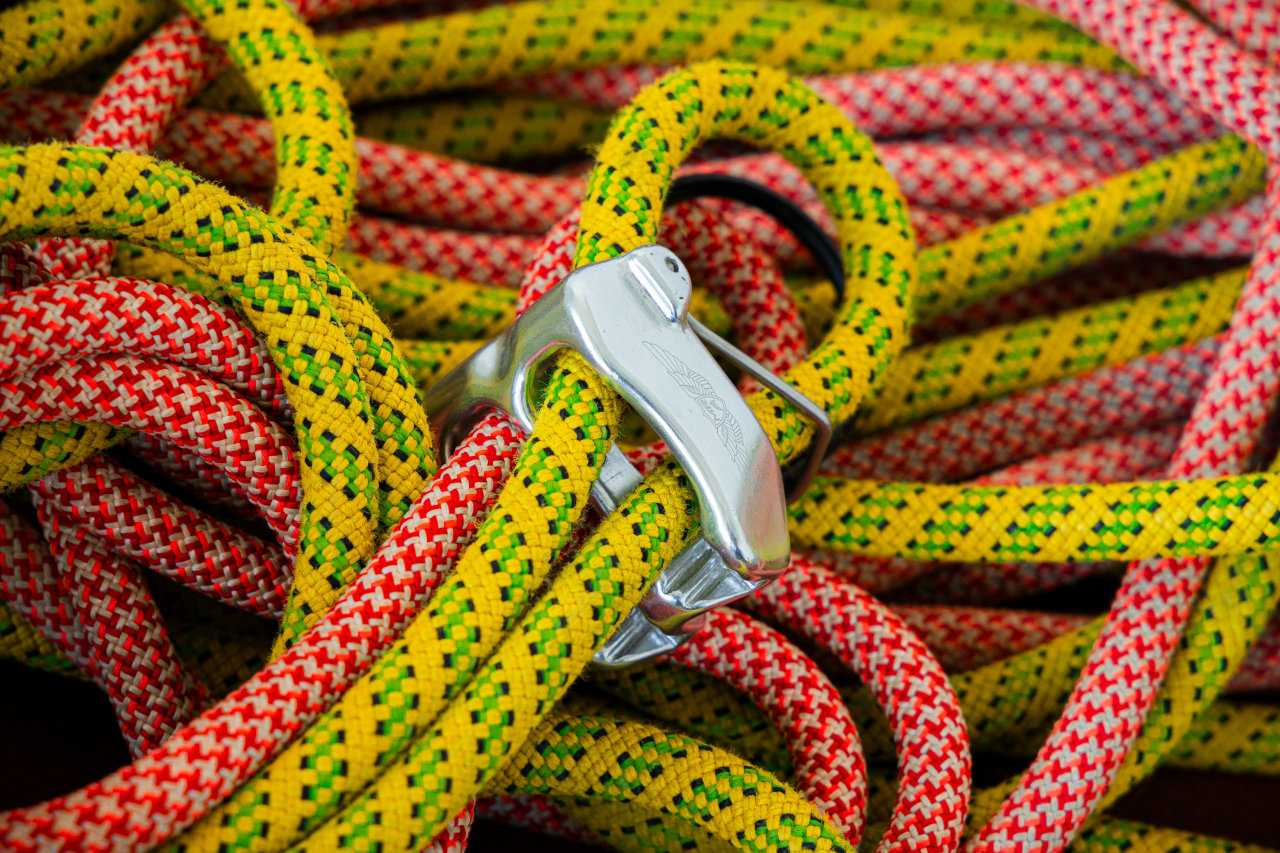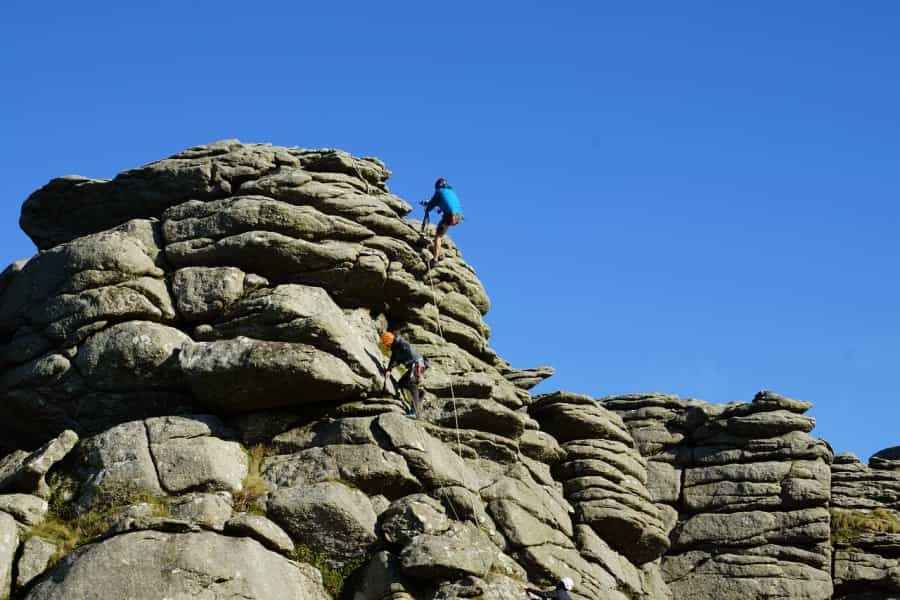Dartmoor Climbing

Dartmoor National Park is famous for its tors – hilltop granite outcrops overlooking the moor that give both fabulous views and a variety of routes and challenges for climbers of all levels. Sport climbing on Dartmoor is prohibited due to the potential damage that fixed anchors can cause to the rocks, but there are plenty of trad climbing and bouldering sites out there to discover. Our guide to Dartmoor climbing takes in some of the best local routes for a range of experience and abilities, plus some useful tips on access, basic safety and, for beginners, guides who can organise climbing trips and tuition.
Bouldering on Dartmoor

Good for core strength, flexibility and coordination, bouldering provides a great introduction to climbing, with the added bonus of requiring no ropes or harnesses. However, the lack of kit doesn’t necessarily imply that it’s easy. The following sites have something to offer for a range of abilities and experience.
Hound Tor
An easily accessible site close to Widecombe in the Moor, Hound Tor has a range of bouldering routes to test climbers of all abilities. There are no end of low- to middle-grade problems and scrambles for beginners to tackle, and UK Climbing’s Hound Tor page has an exhaustive list.
Access: Easily walkable from Manaton car parks.
Bonehill Rocks
UK Climbing calls Bonehill Rocks ‘the spiritual home of Dartmoor bouldering’, and it’s justifiably popular with both locals and visitors. It has some of the best beginner boulders on Dartmoor, and there’s also a good selection of challenges for more experienced climbers. For more details, check out David Henderson’s guide on the Climber Magazine website, or this one courtesy of The Crag, which has details of around 40 different problems. As an added bonus, you can park very close by.
Access: Follow the road from Haytor to Widecombe and turn right at Harefoot Cross (signposted Manaton and Hound Tor). Follow the road for 350m and take the small lane on the left as the road bends right. After 200 metres the rocks come into view.
Saddle Tor
Featuring many challenging problems, Saddle Tor is particularly good for more experienced bouldering enthusiasts, and consequently less busy than nearby Haytor and Hound Tor. UK Climbing’s Saddle Tor page is a great place to brush up before you go.
Access: The tor is a mile west of Haytor on the B3387 and there’s a car park a five-minute walk from the site.
Smallacombe Rocks
Due to its secluded location, it’s pretty likely that you’ll have Smallacombe to yourself. There are lots of good problems for intermediates here, from slabs to vertical walls and overhanging roofs, but bear in mind that the site is quite high and exposed – try to pick a day with good weather. David Simmonite’s fine blog on the Climber Magazine website will tell you what to expect, and for more technical details, try UK Climbing.
Access: A 30-minute walk from the car park by Haytor visitor centre. Follow the old railway and head up to the right after you pass Haytor Quarry.

Accommodation for bouldering access
Pitchup’s guide to the best campsites on Dartmoor has lots of ideas for where you can pitch a tent. Choose a site near Widecombe in the Moor and you’ll be within a short drive of all of our suggested bouldering sites.
Widecombe’s own website has a handy list of local B&Bs and self-catering options.
Traditional (trad) climbing
Trad (traditional) climbing is the predominant form of rock climbing on Dartmoor. In trad climbing, the lead climber places protection equipment as they ascend, and the belayer, or second climber, removes them as they follow. Since it leaves no permanent trace on the rock face, it’s considered more environmentally friendly. Many of the bouldering sites that we suggest also feature plenty of trad climbing routes, but here are another couple of places to try.
The Dewerstone
Rising out of beautiful woodland above the River Plym, the rocky crags of The Dewerstone provide one of Dartmoor’s largest areas for trad climbers to explore, with plenty of routes of low to intermediate level. They’re on National Trust land, so environmental factors here are particularly important. The lesser-frequented routes can be a little overgrown and require clearing before climbing, and the crags are also a haven for local wildlife, so please watch out for (and avoid) any nesting birds of prey in spring.
Classic routes for experienced climbers here include The Leviathan and Vala. We’d recommend taking a look at Tim Dennell’s excellent guide to the Dewerstone, which has details of all the climbs on the crags, with helpful advice on routes and difficulty.
Access: From Dewerstone car park, cross the footbridge and follow the path until it steepens, then head right on a smaller path along the hillside above the river that leads to the crag (approx 20 minutes’ walk).
Sheeps Tor
A great place to climb if you’re looking for fabulous views, the imposing Sheeps Tor overlooks the Burrator Reservoir and the south-west of the moor. It has plenty of easy to mid-grade trad routes with a wide variety of cracks to utilise, and there’s also a bouldering area at the summit. UK Climbing has a good guide to local routes.
Access: Cross the dam at Burrator Reservoir and continue through the village of Sheeps Tor. Take the first right onto the moor, where there are places to park along the road. From here, it’s a short walk up the hill to the crag. Alternatively, park at the reservoir’s arboretum and follow the path uphill through the trees.
Haytor
One of Dartmoor’s most popular tors, Haytor is also one of its best-known climbing areas. The secret is very much out here, so you’ll probably share your visit with hikers and day trippers, and you might find that the routes on the popular High Man are busy. The more tricky Low Man has a couple of Extreme routes that are worth checking out if you’re looking for a real challenge. Bear in mind that it’s also pretty exposed here, so the best time for climbing is in summer. As ever, UK Climbing is the place to go for details of all the routes.
Access: Follow signs to Widecombe-in-the-Moor on the B3387, and park beneath the tor just beyond the turn-off for Haytor Vale. From here, it’s a short, easy walk.
Safety and environmental considerations

Simple safety tips for Dartmoor climbing
Dartmoor’s granite is notoriously tough on the hands, and the exposed nature of most climbing sites means that checking the weather conditions before you depart is essential. Here are a few more simple tips for making the most of your Dartmoor climbing experience.
-
Always use protective equipment - a good helmet and climbing shoes are essential, and a bouldering crash pad is certainly advisable
-
Do some thorough research on your preferred site before you go
-
Choose appropriate clothing for the weather – waterproofs, breathable layers and clothes that don’t restrict your movement are all important
-
Warm up properly and check all your gear before you start to climb
-
Know your limits – don’t overexert yourself or get too ambitious.
-
Test all footholds and handholds before you use them
-
Climb with a partner, and inform someone of your plans, including when you intend to return
-
Carry plenty of food and drink to maintain your energy levels for the duration of your trip
-
Be aware of other climbers
Climbing Magazine has a great article with extensive advice on bouldering safely, and How To Climb Harder have a good online guide to all aspects of rock climbing safety and equipment.
Please respect the natural environment, follow the Countryside Code, and always aim to minimise your impact and leave no trace.
Guided climbing trips
If you’re a beginner, or a visitor with limited time, there are many climbing companies and guides in the Dartmoor area who are happy to arrange tailor-made trips and lessons, with safety and climbing equipment provided. Visit Dartmoor’s climbing page has a few useful suggestions, and the following companies also organise trips:
-
Climb Dartmoor – introductory courses in bouldering and trad climbing for everyone from families to expert climbers
-
Adventure South – lessons and trips for all levels of experience.
-
Adventure Okehampton – introductory courses and taster sessions for all levels
-
Crag 2 Mountain – numerous courses aimed at improving your skills, plus bespoke guided trips
Dartmoor’s tors are great for trad climbing and bouldering, with a wealth of routes for all levels and abilities and the bonus of fabulous countryside views. If you’re planning a climbing trip to Dartmoor, do your research, always consider local safety and environmental issues, and we’re sure you’ll have a day to remember. For more information, visit UK Climbing’s Dartmoor Destination Guide.